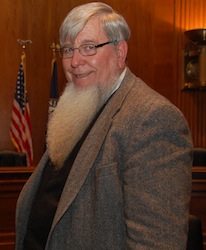 The Marion City Council in Marion, Iowa has unanimously approved a deal with waste-to-energy firm, Fiberight LLC, which gives the Maryland-based firm permission to build a solid waste recycling facility in an industrial area behind the city’s Public Services Center.
The Marion City Council in Marion, Iowa has unanimously approved a deal with waste-to-energy firm, Fiberight LLC, which gives the Maryland-based firm permission to build a solid waste recycling facility in an industrial area behind the city’s Public Services Center.- According to a report prepared by researchers at the University of Guelph, Ridgetown Campus, southwestern Ontario could support the production of a cellulosic sugar plant. The objective of the study was to examine the costs associated with the harvest, aggregation and delivery of corn stalks to a commercial plant and to determine the most viable business model to enable producers to capture a greater share of the value chain while offering a commercial facility stable feedstock supply.
- Commercial property owners, building and sustainability managers are invited to join the San Diego Renewable Energy Society for a free, interactive, behind-the-scenes tour of six energy innovations as part of the 13th San Diego Sustainability Tour. The 13th Sustainability Tour is part of the American Solar Energy Society’s National Solar Tour. With a theme of “Be Sustainably Inspired,” this year’s tour will showcase a “Sweet 16” of unique energy innovations in the residential, non-profit, multi-family and commercial space.
- Registration is still open for the 2013 Alcohol School sponsored by Ethanol Technology Institute. The event is being held September 15-20, 2013 in Montreal, Quebec and is designed to educate delegates on proven technology and advances in fuel ethanol and distilled beverage production.
Better Benchmarks = More Accurate Ethanol Picture
 One of the issues ethanol producers struggle with is some outdated information being used to argue against the positive effects of the green fuel. It’s an issue attendees of the recent American Coalition for Ethanol’s (ACE) “Unite and Ignite” conference in Des Moines, Iowa have been facing for some time. In fact, last March, Joanna talked with Ron Alverson, current President of ACE and who serves on the board of Dakota Ethanol. They spoke during ACE’s Biofuels Beltway event when about 70 ethanol backers gathered in Washington, D.C., to talk ethanol with the Nation’s lawmakers.
One of the issues ethanol producers struggle with is some outdated information being used to argue against the positive effects of the green fuel. It’s an issue attendees of the recent American Coalition for Ethanol’s (ACE) “Unite and Ignite” conference in Des Moines, Iowa have been facing for some time. In fact, last March, Joanna talked with Ron Alverson, current President of ACE and who serves on the board of Dakota Ethanol. They spoke during ACE’s Biofuels Beltway event when about 70 ethanol backers gathered in Washington, D.C., to talk ethanol with the Nation’s lawmakers.
“When the Renewable Fuels Standard was created, it was mandated that they do life cycle assessments of carbon intensity for all these fuels, including gasoline and all these biofuels, to give us a benchmark about where we sat in terms of carbon reduction. And the first benchmarking that was done used very old data for ethanol,” he said, giving ethanol a carbon intensity score similar to gasoline. That prompted the environmental groups to quickly turn against ethanol. But five years later, Ron said there’s lots of new data out there that shows a dramatic lowering of ethanol’s life cycle carbon rating. “We’re really pleased to see that new data come out, and [soon] we’ll have that carbon intensity of corn ethanol down to at least 50 percent of gasoline.”
Ron said that each ethanol plant can make their case again to the California Air Resource Board (ARB) to show how much better ethanol really is. But even without new approvals, he believes ethanol still makes a very strong case in the economic benefit it has brought to rural America, pointing to his own community back in South Dakota, where his company’s ethanol plant is located.
“So much more economic activity going on now. We’ve created about 45 jobs at the ethanol plant, and the town only has 200 people!” Ron said. Plus, all over the ethanol industry, farmers are seeing more markets and more value for their corn, and in turn, for everything else in those rural communities. That’s a good story to tell. “Get the facts out, and I’ll think we’ll win the war.
Listen to Joanna’s interview with Ron here: Ron Alverson, current President of ACE
Paper Challenges EPA Modeling of Ethanol Emissions
A new white paper released by the Ethanol Across America Campaign finds that mid-Level ethanol blends can provide significantly greater emission and health benefits than U.S. Environmental Protection Agency (EPA) models indicate. “Understanding the Emissions Benefits of Higher Ethanol Blends: EPA Modeling Fails to Tell the Whole Story,” was authored by Steve Vander Griend of the Urban Air Initiative and released during the 26th Annual Ethanol Conference.
 “Adding ethanol to gasoline improves it in every way. It lowers carbon, reduces common air pollutants for smog formation, lessens CO2 emissions, reduces sulfer content, and provides clean octane as a replacement for toxic aromatics. In short, it makes gasoline significantly better than what would otherwise go into your tank. EPA’s modeling does not show that to be the case, but it should.” This begins the white paper debunking the research that the Environmental Protection Agency (EPA) commissioned to show that gasoline blended with E30 (30% ethanol, 70% gasoline) is dirtier than gasoline not blended with ethanol.
“Adding ethanol to gasoline improves it in every way. It lowers carbon, reduces common air pollutants for smog formation, lessens CO2 emissions, reduces sulfer content, and provides clean octane as a replacement for toxic aromatics. In short, it makes gasoline significantly better than what would otherwise go into your tank. EPA’s modeling does not show that to be the case, but it should.” This begins the white paper debunking the research that the Environmental Protection Agency (EPA) commissioned to show that gasoline blended with E30 (30% ethanol, 70% gasoline) is dirtier than gasoline not blended with ethanol.
Vander Griend writes that ethanol’s chemical property has a beneficial distillation point that makes it almost impossible for it to cause the kinds of increases EPA claims. In fact, he argues, it is the highly toxic aromatics added to gasoline in the EPA testing procedures that cause significant increases in criteria emissions. He makes the case that ethanol is a superior blending agent that can replace toxic components of gasoline used for octane. Ethanol provides clean octane that, when properly blended, would create value for blends well beyond 10 percent volume.
The EPA findings relate to the Renewable Fuel Standard (RFS) and a specific model developed by the EPA required in the Energy Independence and Security Act of 2007.
Click here to read the whitepaper. Visit the ACE 26th Annual Ethanol Conference photo album.
Merle Anderson on Ethanol
 Merle Anderson is 93, the founding father of the American Coalition for Ethanol (ACE) and has never missed an ethanol conference and this year was no exception. Anderson gave a few brief words (and told some pretty funny stories) and said that he was very proud of what the ethanol industry had accomplished. He also said that he is very proud of the work that the ACE team has done over the years.
Merle Anderson is 93, the founding father of the American Coalition for Ethanol (ACE) and has never missed an ethanol conference and this year was no exception. Anderson gave a few brief words (and told some pretty funny stories) and said that he was very proud of what the ethanol industry had accomplished. He also said that he is very proud of the work that the ACE team has done over the years.
Anderson said he had some stuff on his mind. He said that if you’re going to open up an ethanol plant or begin a new project, you’d better support the sale of the product. “One thing this country’s doesn’t need is more ethanol we can’t sell,” said Anderson who encouraged members to become more involved in efforts like the Biofuels Beltway March.
He also said he felt that farmers could do a better job of supporting the industry and challenged the ethanol industry to do more to encourage their support.
In addition, Anderson encouraged ACE to continue to support higher blends of ethanol including E30, so that the industry can overcome the so-called blend wall.
Listen to Merle Anderson’s remarks here: Merle Anderson on Ethanol
Blue Marble Closes on Land Deal for Biorefinery
Blue Marble Biomaterials has closed on the purchase of the former GTC Oats Inc. located in Missoula, Montana. Previously, this site was a wet extraction processing plant for the creation of food ingredients. The purchase includes 3.81 acres of land, a 19,000 square foot building complex, and parking stalls for over 100 employees. The building retrofits include systems that will allow for greater energy efficiency and enable the site to be a showcase for the company’s “zero-‐waste” focus.
 “We are excited to announce the purchase of this site which will become our first Large Commercial Bio-Refinery. The acquisition of this facility fulfills the next stage of our scaling plan to begin offering an expanded portfolio of products to global customers,” said Colby Underwood, Co‐CEO and Chief Business Officer for Blue Marble Biomaterials. “In 2011, two percent of all chemicals sold globally were sustainable. By 2025, the USDA predicts that 44% of all chemicals sold will be sustainable. Everyday, we see the explosive growth that is occurring with natural bio-chemicals. With the increased production capacity of this facility and others planned for the future, we will become one of the bio-chemical market leaders.”
“We are excited to announce the purchase of this site which will become our first Large Commercial Bio-Refinery. The acquisition of this facility fulfills the next stage of our scaling plan to begin offering an expanded portfolio of products to global customers,” said Colby Underwood, Co‐CEO and Chief Business Officer for Blue Marble Biomaterials. “In 2011, two percent of all chemicals sold globally were sustainable. By 2025, the USDA predicts that 44% of all chemicals sold will be sustainable. Everyday, we see the explosive growth that is occurring with natural bio-chemicals. With the increased production capacity of this facility and others planned for the future, we will become one of the bio-chemical market leaders.”
Blue Marble expects to see significant growth in the coming months, as the site purchase comes just as the company begins closing a $15 million debt financing deal through the USCIS EB-5 Program. The EB-5 Program was created by Congress in 1990 as a mechanism to stimulate economic activity, encourage foreign investment in US companies, and create domestic jobs. Currently employing 24 people, Blue Marble believes it is one of the first biotechnology companies to take advantage of the program and expects to create over 300 direct and indirect jobs in the Missoula area as a result of the financing and recent site purchase.
Underwood added, “On behalf of the entire Blue Marble team, I would like to thank Governor Steve Bullock, U.S. Senator Jon Tester, U.S. Senator Max Baucus, Congressman Steve Daines, and Missoula Mayor John Engen for their support on behalf of this purchase and our company. We would also like to thank the hard working employees of the Missoula Job Service, Bitterroot Economic Development District, and Missoula County.”
Mexico Looks to Build Biodiesel Plant
 Scientists in Mexico want to build a biodiesel plant that would provide fuel for Mexico City’s public transit. This story in the Latin American Herald Tribune says the the National Autonomous University of Mexico (UNAM) plan is to use waste cooking oil from restaurants and hotels and could supply more than 500 gallons a day.
Scientists in Mexico want to build a biodiesel plant that would provide fuel for Mexico City’s public transit. This story in the Latin American Herald Tribune says the the National Autonomous University of Mexico (UNAM) plan is to use waste cooking oil from restaurants and hotels and could supply more than 500 gallons a day.
A School of Engineering lab will be responsible for sourcing and quality control for the first project of this type in Mexico, postgraduate researcher Alejandra Castro Gonzalez said.
The quality of the source oil and the biodiesel must be high to ensure the smooth operation of vehicles using it as fuel and avoid damaging engines, Castro said.
Use of biodiesel will help reduce emissions of pollutants, as well as recycling a product that is now often discarded, the researcher said.
“Some (establishments in Ciudad Universitaria) discard about 70 percent and others just 20 percent (of cooking oils), so we can deduce that there are shops that cook more healthy than others,” Castro said.
The project is getting funding from the Conacyt Mixed Fund and the Federal District’s government.
Hyrdogenics’ Power-to-Gas Facility Begins Operations
Hydrogenics Corporation has announced that its E.ON inaugurated commercial operations has begun at its Power-to-Gas (P2G) facility in Falkenhagen, Germany. The plant uses wind power and Hydrogenics’ electrolysis equipment to transform water into hydrogen, which is then injected into the existing regional natural gas transmission system. The hydrogen, as part of the natural gas mix, can be used in a variety of applications including space heating, industrial processes, mobility, and power generation. The facility, which has a capacity of two megawatts, produces 360 cubic meters of hydrogen per hour.
 “This project makes E.ON one of the first companies to demonstrate that surplus energy can be stored in the gas pipeline system in order to help balance supply against demand,” said Dr. Ingo Luge, CEO of E.ON Deutschland. “This method of energy storage is considered a key technology for the transformation of Germany’s energy system. It will reduce the need to take wind turbines offline when the local grid is congested and will therefore enable us to harness more wind power.”
“This project makes E.ON one of the first companies to demonstrate that surplus energy can be stored in the gas pipeline system in order to help balance supply against demand,” said Dr. Ingo Luge, CEO of E.ON Deutschland. “This method of energy storage is considered a key technology for the transformation of Germany’s energy system. It will reduce the need to take wind turbines offline when the local grid is congested and will therefore enable us to harness more wind power.”
Swissgas, which represents over 100 local natural gas utilities, is a partner in the project with a 20 percent capital stake and an agreement to purchase a portion of the gas produced. Dr. Heinrich Schwendener, a member of the organization’s Board of Management, said during an inauguration ceremony, “Swissgas’ involvement demonstrates the significant value of Switzerland’s gas infrastructure, which enables us to transport and store regenerative energy across national boundaries.”
The inauguration ceremony was also attended by Dr. Philipp Rosler, Germany’s Economics and Technology Minister; Dr. Christian Ehler, Member of the European Parliament; and Henning Heidemanns; State Secretary in the Ministry of Economics and European Affairs of the Federal State of Brandenburg, along with nearly 200 other guests.
“One of the biggest challenges of transforming Germany’s energy system is finding ways to integrate the increasing share of intermittent, renewable-source energy,” said Minister Rosler. “To ensure that Germany’s power system remains stable and that our economy continues to have the energy it needs, we not only have to rapidly expand energy networks but also require innovative solutions like the P2G unit here in Falkenhagen.”
Daryl Wilson, CEO of Hydrogenics, added, “We are delighted to see this plant now in full commercial use. In April of this year we announced a second Power-to-Gas project with E.ON for the city of Hamburg, which is currently under construction. That facility, containing the world’s largest single mega-watt PEM stack, is expected to be delivered in the spring of 2014. These projects serve as a platform for upcoming Power-to-Gas facilities not only in Europe but around the world.”
BioEnergy Bytes
 The 2nd Myanmar Power Summit will be taking place September 23-25, 2013 at the Sedona Hotel Yangon. The complete agenda is now available. His Excellency U Khin Maung Soe, Union Minister of Electric Power, Myanmar will inaugurate the three-day summit with a keynote address. The summit brings together Myanmar government’s spokespersons as well as industry players to provide latest update on power situation in Myanmar, government plans and more.
The 2nd Myanmar Power Summit will be taking place September 23-25, 2013 at the Sedona Hotel Yangon. The complete agenda is now available. His Excellency U Khin Maung Soe, Union Minister of Electric Power, Myanmar will inaugurate the three-day summit with a keynote address. The summit brings together Myanmar government’s spokespersons as well as industry players to provide latest update on power situation in Myanmar, government plans and more.- Sierra Instruments, a global mass flow instrument manufacturer, has released a new, free biogas measurement white paper. “Precise Biogas Measurement: Overcoming the Challenges of Changing Gas Composition,” offers engineers, as well as plant and facilities managers, solutions for precise biogas measurement even with the changing gas composition, an inherent application challenge in biogas energy flow measurement.
- Goldpoly New Energy Holdings Limited announced that it has entered into a strategic cooperation agreement as well as an agreement for the acquisition of 100MW of roof-top solar power plants with China Singyes Solar Technologies Holdings Limited. The strategic cooperation agreement between Goldpoly and Singyes proposes that both parties will strategically cooperate with respect to roof-top and ground solar power plants, micro-grid projects, green energy-saving buildings, application of low-carbon new energy in the islands in China as well as development of green, intelligent low-carbon, satellite cities in China.
- The City of Lemoore and Chevron Energy Solutions are starting the construction of an expansive solar installation to power domestic water wells, a wastewater treatment plant, the Cinnamon Municipal Complex, Police Department, and several other facilities throughout the city. The project is expected to generate over 3 megawatts of electricity and reduce purchases from the electric utility by close to 100 percent for most of the facilities included. Over its life, and after paying all its costs, the City of Lemoore is expected to save close to $45 million.
Hawaiian Utilities Seek Biodiesel as Clean Fuel
 Hawaii is known for its lush, green jungles. Now, the islands would like to go green environmentally. Hawaiian Electric Companies put out the call to get biodiesel as part of the utilities’ 150,000 barrels of green fuel a year used to supply Maui Electric and Hawaii Electric Light Company generation facilities:
Hawaii is known for its lush, green jungles. Now, the islands would like to go green environmentally. Hawaiian Electric Companies put out the call to get biodiesel as part of the utilities’ 150,000 barrels of green fuel a year used to supply Maui Electric and Hawaii Electric Light Company generation facilities:
This request for proposals offers biodiesel suppliers — including local biodiesel producers — the opportunity to offer biodiesel or biodiesel blends for all or part of the required volumes on Maui, Molokai, Lanai or Hawaii Island. Proposals will be considered if the biodiesel price is competitive with the price of ULSD.
Hawaiian Electric continues to use 100 percent renewable biodiesel on Oahu in the Campbell Industrial Park Generating Station. It will also do so in the planned Honolulu International Airport Emergency Generation Facility. In addition, all diesel vehicles in the Hawaiian Electric fleets use B20, a blend of 20 percent biodiesel with 80 percent petroleum diesel.
The push to use biodiesel is part of a larger plan by the utilities to use more renewable energy, including solar, wind, geothermal, biomass, hydro, and, eventually, ocean-generated power.
Get your biodiesel bid into www.hawaiianelectric.com/fuels by Oct. 15, 2013. The three-year contract is expected to start January 1, 2015.
ACE Gets Out Ethanol’s Message
 This week, we’ve been telling you about the American Coalition for Ethanol’s (ACE) “Unite and Ignite” conference in Des Moines, Iowa. And while the attendees have been talking ethanol in Iowa, we’ve also given you some insights from ACE’s Biofuels Beltway March earlier this year when about 70 ethanol backers gathered on Capitol Hill to talk ethanol with the Nation’s lawmakers. During that visit, Joanna caught up with Ray Defenbaugh with Big River Resources, an ethanol producer and advocate who was surprised just how much misinformation is still out there about the green fuel.
This week, we’ve been telling you about the American Coalition for Ethanol’s (ACE) “Unite and Ignite” conference in Des Moines, Iowa. And while the attendees have been talking ethanol in Iowa, we’ve also given you some insights from ACE’s Biofuels Beltway March earlier this year when about 70 ethanol backers gathered on Capitol Hill to talk ethanol with the Nation’s lawmakers. During that visit, Joanna caught up with Ray Defenbaugh with Big River Resources, an ethanol producer and advocate who was surprised just how much misinformation is still out there about the green fuel.
“During the presidential campaign and people running for legislative office, we heard frequently that we’re not getting our message out. As much as we’ve tried, there’s still some people who haven’t gotten it, or they’ve gotten it inaccurately,” he said. The group fielded lots of questions about food-versus-fuel, energy usage during production, impacts on corn stocks and more. In addition, they had to head off those who thought there should be delays in implementing the Renewable Fuels Standard. “We were able to explain to them what that would do as far as uncertainty for future development of the cellulosic industry, and we were able to explain that the RFS is working with many of their concerns already addressed in the RFS.”
Ray said the information was well received, but he was surprised just how many didn’t understand the relationship of ethanol and the lack of subsidies, how animal feed supplies are really not impacted by ethanol production, and the intricacies of the RFS.
“Several of them did not understand the impact that (losing the RFS) would have on our rural communities and farmers today,” explaining to many in Congress that renewable energy has also meant good prices for commodities, meaning fewer subsidies… tax dollars… needed to go to farmers.
Ray said it’s just a matter of educating people about ethanol, something that those connected to the industry need to do all the time.
“We have a really good product and industry, and be patient [on cellulosic]. There will be a growth on that cellulosic industry that compares to what the corn ethanol did.”
Listen to Joanna’s interview with Ray here: Ray Defenbaugh, Big River Resources

